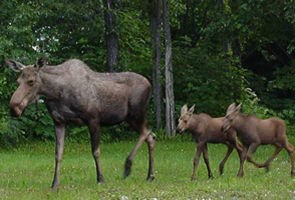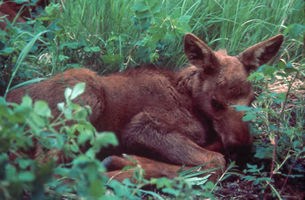
NPS Photo Visitors are often concerned about encountering bears; yet in Alaska more people each year are injured by moose than by bears. Moose aren’t inherently aggressive, but will defend themselves if they perceive a threat. It is important to not approach too closely and put yourself at risk. Give Moose Plenty of Room!Enjoy viewing them from a distance. Stay at least 25 yards (25 m) away from moose. Cow moose are extremely defensive of their young so use extra caution around cows with calves - don't get between a mother and her calf. In the summer months, moose blend in well to their environment and can be surprisingly hard to see for such large animals. They are likely to stand their ground even when they hear people approaching, so pay close attention to your surroundings, especially in prime moose habitat such as willow thickets or around streams or ponds. 
NPS Photo Watch For Signs that the Moose is UpsetIf its ears are laid back and hackles are up, a moose is upset. When upset, it could decide to charge. Most of the time, when a moose charges it is a ‘bluff’, or warning for you to get back – a warning you should take very seriously! Once a moose bluff charges, it is already agitated. If possible, get behind something solid (like a tree or a car). Unlike with bears, it is okay to run from a moose. They usually won’t chase you and if they do, it’s unlikely that they’ll chase you very far. If a moose knocks you down, curl up in a ball and protect your head with your arms and keep still. Fighting back will only convince the moose that you may still be a threat. Only move once the moose has backed off to a safe distance or it may renew its attack. If You Do Find Yourself Close to a Moose...
|
Last updated: December 27, 2017
